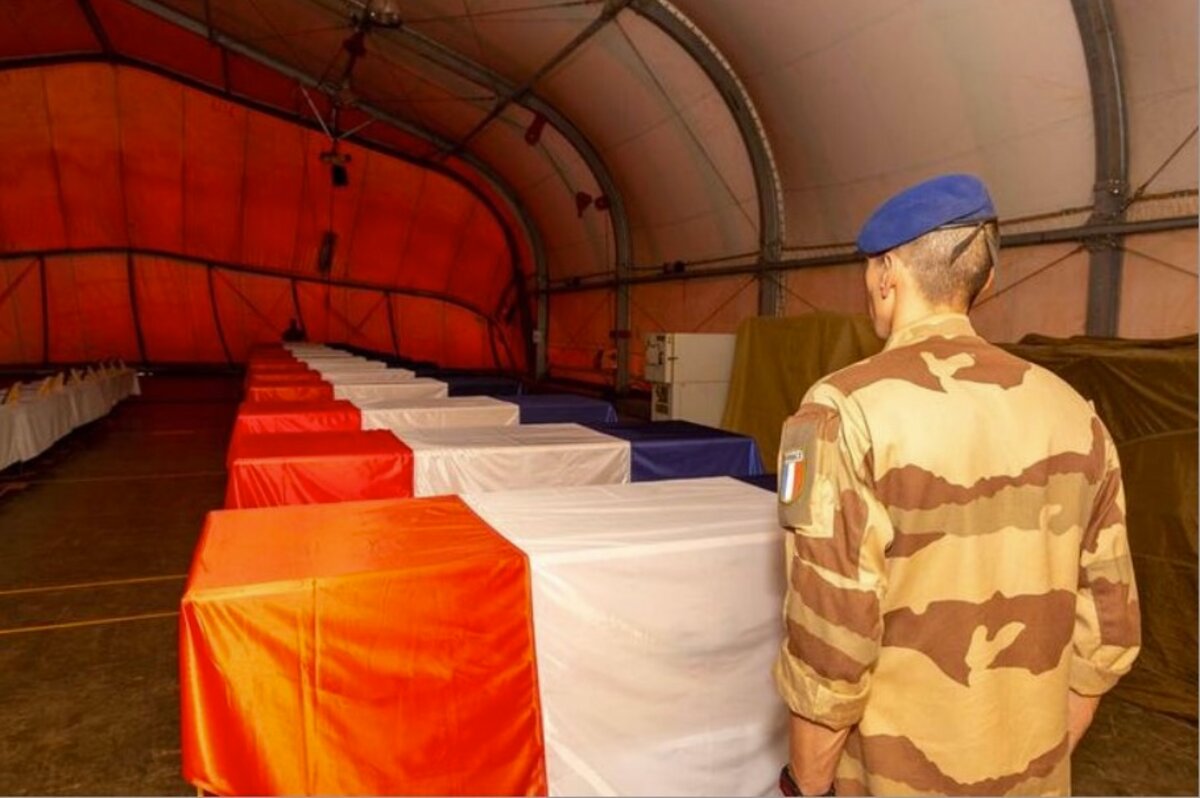The death of 13 members of the French military in a collisions between two helicopters in Mali on Monday November 25th led to public mourning and much media coverage back in France. But will it finally start a public and Parliamentary debate about the wider objectives and strategy of Operation Barkhane? This is the name of France's intervention in Mali and the wider Sahel region in Africa which in August 2014 superseded Operation Serval, the military intervention launched by President François Hollande in January 2013.
This is far from certain. Indeed, it is perhaps even unlikely given the atmosphere of patriotic fervour created by head of state Emmanuel Macron, whose grandiloquence provided a rather awkward tribute following the tragic fate of these 13 soldiers.
On Thursday November 28th President Macron declared that he was ready to review all of France's “strategic options” in the Sahel region of Africa, the lands between the Sahara to the north and the savannah to the south. Speaking just a week before the NATO summit in London he called for “greater involvement” from France's allies in the fight against “terrorism” in the region. He also said in the coming weeks he would be calling for a “detailed study from the government and our armed forces to look at the ways we intervene”.

Enlargement : Illustration 1

But the president made no mention of the serious questions raised by what one is obliged to call France's stalemate – or at least the beginnings of a stalemate – in the Sahel. While military action against the armed Islamic groups is legitimate and necessary for security in the region and Europe, is it enough? Are the jihadists the only source of chaos in the Sahel? And if there are other causes of problems on the ground, are we doing what needs to be done to identify and eliminate them?
The objective of Operation Serval, a military operation launched in January 2013, was in theory quite simple. It was at least clearly defined. It involved stopping the jihadist adavance which was at the time threatening Mali's capital Bamako, retaking control of Timbuktu, ending the establishment of terrorism in the north of Mali, and then transferring the role of stabilising the country to a reinforced Malian army and United Nations 'blue helmet' troops from the United Nations Multidimensional Integrated Stabilization Mission in Mali (MINUSMA).
The first part of the mission was accomplished six months later. Bamako was saved and Timbuktu was liberated from the jihadists. But the fight against the armed Islamist groups and their presence in the entire Sahel zone from Mauritania to Chad – an area as big as Europe – was far from being won. That led to the launch in August 2014 of Operation Barkhane – which takes its name from the word for a crescent-shaped dune in the Sahara desert – based on a partnership with the five countries in that region: Mauritania, Mali, Niger, Chad and Burkina Faso.
According to France's Defence Ministry, this operation's priority aim is to help the countries of the “G5 Sahel” to take ownership of the “fight against the armed terrorist groups”. Today more than 4,500 French soldiers, supported by seven fighter planes, around 20 helicopters, three drones, around ten transport aircraft and five hundred armed vehicles, make up the Barkhane force, which has four main bases – at N’Djamena, Niamey, Gao and Ouagadougou – and around ten advanced bases.
Over the course of time several foreign military detachments have joined forces with Operation Barkhane. The United Kingdom sent two heavy Chinook helicopters with their crews. Belgium, Norway and Holland have lent transport aircraft; and since 2018 the United States has had a base at Agadez in Niger from where armed drones are deployed. Close to 600 soldiers, supplied from 20 or so European Union countries, help with the training and organisation of the Malian army. And since August 2018 around 50 Estonian soldiers have been involved in the defence of the operational base at Gao on the gateway to the Malian desert, and this number will soon be doubled.
This Gao base will also be the headquarters for the coalition unit of European special forces that has just been announced. Based around the 'Task Force Sabre' contingent of French special forces, this unit will initially be made up of Estonian, Czech, Belgian and Norwegian soldiers. Over time though this new 'Task Force Takuba' – using the local Tuareg word for sabre – is due to contain soldiers from around ten countries in all and from the summer of 2020 their mission will be to advise units of Mali's army on combat operations.
On paper the Barkhane force also has the support of 5,000 soldiers from the G5 Sahel force and the 13,000 MINUSMA blue helmets. But the Sahel military coalition, which was set up by Mali and its four neighbours back in November with the support of Paris, is still not operational. That has been admitted by the foreign minister of Burkina Faso, which is the currently in the chair of the organisation's rotating presidency.
'The jihadists are offering responses to local situations of oppression and dispossession'
Even though its first combat operation was two years ago, the G5 Sahel force still lacks training, equipment and money. Though the 10 million dollars promised by the United Arab Emirates has come through, the contribution from Saudi Arabia, which was supposed to stump up 100 million dollars, has still not arrived. In addition, several contingents of the G5 Sahel force have shown dubious respect for human rights.
Meanwhile the UN MINUSMA force, which has units from around 50 countries, and which is badly equipped, badly trained and sometimes badly led, has already lost more than 200 people since its deployment in 2013. According to one French soldier: “They spend most of their time barricaded in their bases.” In other words, most of the “finding and destroying” of the armed Islamist groups falls back on the 4,500 troops from Operation Barkhane. They face a daunting task if one considers that much of the area they are operating in is desert and if it were located in Europe would stretch from Brest in western France to Kiev, and from Copenhagen to Rome.
According to French military intelligence the “armed terrorist groups” spread across the vastness of this border-less terrain consist of around 2,000 fighters, with 1,000 to 1,400 of them in Mali alone. Even though attacks, incursions and recruitment by fighters or sympathisers are reported in Niger, Burkina Faso and Chad, it is in the Mali part of the Liptako-Gourma area where the main centre of terrorist activity is centred, according to the French military.
It was in this “three-frontier” region – Mali, Niger and Burkina Faso – which facilitates all kinds of trafficking, that the military operation took place on Monday November 25th in which the 13 French troops died when two helicopters collided. The Malian army suffered heavy losses in the same region in and around Boulikessi in September 2019, when armed groups attacked two bases, then a month later 49 troops were killed at Indelimane.
French intelligence agencies believe there are at least three groups active in the region, a view confirmed by academics who specialise in the area. The largest or most active group is the Islamic State in the Greater Sahara (ISGS) which, like Islamic State did in the Middle East, wants to establish a caliphate in the middle of Africa. The fact that Abu Bakr al-Baghdadi's caliphate in the Middle East lost its lands in Iraq and Syria before seeing many of its fighters killed by international coalition air strikes and the Kurds has clearly not deterred the ISGS's chiefs from seeking their own caliphate. The ISGS's military force consists of two combat units based on the ethnic and tribal realities of the region. The first of these brigades is made up mostly of Tuaregs, the other of Fula nomads.
Another active group in the region is Jama'a Nusrat ul-Islam wa al-Muslimin' (JNIM), known in English as the Group to Support Islam and Muslims (GSIM) which has links with Al Qaeda, plus Ansarul Islam, which emerged three years ago in the north of Burkina Faso. Compared with Operation Barkhane these groups have modest numbers and fighting capability and their main strength is the support they get from the local population. They are very at home in the local villages. And like scorpions hiding under a stone, they choose when to strike before vanishing into the arid landscape.
One characteristic that is common to the entire region is that these groups do not base their support on great piety and religious fanaticism but on their ability to respond to certain needs and to express the local people's sense of grievance. In countries where the state administration and services are failing and where regimes are corrupt, they provide a form of security and protection to the villagers. According to work by academic Roland Marchal of the Center for International Studies at Sciences Po university in Paris – who for reasons unknown is currently being held by the regime in Iran along with his partner and fellow academic Fariba Adelkah – these jihadist groups “are not growing for ideological reasons. They are offering responses to local situations of oppression and dispossession.”
Against a state that is blind to local wishes and demands for decentralisation, and blind to local revolts against the brutality of forces of law and order when they do turn up, these armed groups cleverly exploit tribal and ethnic quarrels and rivalries. This is the case with the potentially explosive conflict in Mali between the Fula nomadic people and the Dogon farmers. In a region affected by climate change, the Fula, who complain of the unequal distribution of the land and natural resources, criticise the expansion of agriculture to the detriment of pastoralism. They plan to keep open the routes for their livestock to pass, by force if necessary, even when their way is barred by new arable fields.
The jihadists, who some time ago worked out what they can gain from this conflict, have made the Fula tribes a key target in their recruitment. Indeed, they have done this so successfully that it is now difficult to separate ideological and religions motivations from simple ethnic and local settling of scores in the increasingly bloody clashes between armed Fula groups and Dogon militia armed by the government. The situation is made even more complicated by the fact that, because there are no deep ideological roots, people can switch allegiance from one day to the next, according to their perceived interests at the time. The one constant factor is a rejection of the central government which is seen as incompetent or unfair and violent. This means that throughout the Sahel region soldiers and gendarmes have become targets. This includes French soldiers who are seen as allies and protectors of the hated regimes.
This is why, says Roland Marchal, European “must accept that the heart of the crisis is not jihadism but the functioning of the Sahel states”. In other words, military action cannot be the only response to check the expansion of armed Islamists, even if it should not be discarded either. The enemy certainly adapts very quickly to the new fighting conditions, and is dispersed over a wide distance and elusive. The Sahel jihadists are also regular and astute users of social media, using encrypted messages and satellite communications, and have long grasped that the permanent aerial patrols by reconnaissance planes and drones and electronic surveillance put them at risk. So they have re-established a system of motorbike couriers with a secure network to transfer operational information and orders.
So the fight against the danger of Islamist terrorism involves a capacity to weaken the existing networks militarily. But it also requires – perhaps more than anything else now – a new analysis of the situation on the ground, through a thorough examination of how the local regimes function. It also requires convincing action from Europe to achieve a radical transformation of the Sahel regimes and our relations with them. But, hampered by past colonial links and the unhealthy networks of what is known as 'Françafrique' – defined by some in Africa as the “continuous subjugation of supposedly sovereign African states … by their former colonial master, in this case France” - is Emmanuel Macron's France able to urge such a strategic revolution? The French president's most recent utterances, which relate only to the military dimension of the problem, would perhaps suggest not.
-------------------------------------------------------------------------
The French version of this article can be found here.
English version by Michael Streeter


